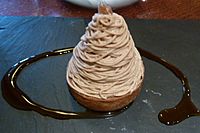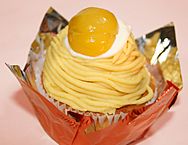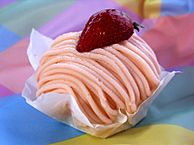Mont Blanc (dessert) facts for kids

Mont Blanc
|
|
| Type | Dessert |
|---|---|
| Place of origin | Italy, France |
| Main ingredients | Chestnuts, whipped cream |
A Mont Blanc is a sweet dessert made mostly from sweetened chestnuts. It looks like a pile of thin chestnut noodles, called vermicelli, topped with fluffy whipped cream. The name "Mont Blanc" means "White Mountain" in French, and the dessert is named after the famous snowy mountain in Europe because it looks like a snow-capped peak!
This tasty treat first appeared in the 1800s in Piedmont, a region in Italy.
Contents
What is Mont Blanc?
Mont Blanc has been a popular dessert, especially in autumn and winter. Many famous bakeries in Paris, France, have served it for a long time. One very well-known place is the tea shop Angelina, which has made Mont Blanc a special item since it opened in 1903.
For a while, some people thought Mont Blanc was old-fashioned or too heavy. But in the 2010s, it became popular again! Newer bakeries, like Pierre Hermé, started making lighter and more modern versions.
Today, Mont Blanc is enjoyed in many countries around the world. You can find it in France, Italy, Hong Kong, Shanghai, Japan, Slovakia, Switzerland, Hungary, and parts of Romania.
The History of Mont Blanc
People have used chestnut purées in cooking for a very long time. They were often used in soups, porridges, or as a side dish with meat, especially in places where chestnuts were a main food. But these were not sweet desserts, and they didn't have whipped cream.
The Mont Blanc dessert we know today has three special things that make it unique:
- It is sweet.
- It is made from chestnut purée shaped like thin noodles (vermicelli) or a mountain.
- It is covered with lots of whipped cream.
Early French cookbooks from 1842 mentioned a sweet dish of puréed chestnuts shaped like vermicelli. However, this early version didn't include the whipped cream that is now a key part of Mont Blanc.
Around 1847, a dessert called entremets du Mont-Blanc or simply montblanc was created by the Dessat(s) pastry shop. It was described as a sweet mix of chestnuts and cream. People loved it so much they said it would make the creator's name "immortal"!
By 1885, a clear description of Mont Blanc appeared. It was called torche aux marrons and was known as a dish from the Alsace region. This recipe had puréed chestnuts topped with whipped cream. An article from 1892 explained that torche was the Alsatian name for what was called Mont Blanc in southern France. It was also sometimes called marrons chantilly (chestnuts with whipped cream).
The name Mont-Blanc aux marrons (Mont Blanc with chestnuts) became common around 1888-1893. The famous chef Auguste Escoffier included it in his cookbook, Guide Culinaire, in 1903. He even suggested piling the whipped cream unevenly to make it look more like a rugged mountain.
In 1933, Mont Blanc was brought to Japan. A pastry shop in Tokyo, also called Mont-Blanc, was inspired by the Angelina shop in Paris. The Japanese version often used yellow chestnuts preserved in syrup.
How to Make Mont Blanc
Mont Blanc can be made in a few ways:
- You can cook fresh chestnuts in a light sugar syrup or in milk.
- You can cook them in plain water and add sugar later.
- Some people use ready-made canned crème de marrons. This is a sweet purée made from broken chestnuts left over from making marrons glacés (candied chestnuts).
Once the chestnut purée is ready, it's usually pushed through a special tool to make thin, noodle-like strands. These strands are then shaped into a ring or a cone. Finally, big dollops of whipped cream are placed on top or in the middle, making it look like a snowy mountain.
Different Kinds of Mont Blanc
There are many fun ways to make Mont Blanc:
- Sometimes, the chestnut purée is shaped in a mold instead of being made into vermicelli. This can make the dessert feel a bit heavier.
- The original Mont Blanc was a large dessert meant for many people to share. But today, you can often buy smaller, individual servings at bakeries.
- In France, Mont Blanc is sometimes served on a base of meringue (a sweet, crispy treat made from egg whites and sugar) or a biscuit.
- Chefs might add other flavors or decorations, like chocolate, rose syrup, or fresh berries.
- Some variations even use chestnuts in the meringue or biscuit base, without any chestnut purée at all!
- A very simple version just mixes crème de marrons with crème fraîche (a type of sour cream) and serves it in a bowl, without shaping it like a mountain.
- In Shanghai, China, traditional bakeries often serve Mont Blanc with short chestnut vermicelli on a sponge cake base. These versions also tend to have a thick, unwhipped cream topping and are sometimes served in cups. This style is said to have been created by a German chef and is now a popular local dessert called “li zi dan gao,” or chestnut cake.
- In Japan, chefs sometimes use other ingredients instead of chestnuts, like pumpkin, squash, or purple yam. They might also add cocoa or matcha (green tea powder) for different flavors. There are even fruit Mont Blancs with flavors like mango and strawberry! These fruit versions might not have chestnuts, but they still keep the fun vermicelli shape.
See also
 In Spanish: Mont Blanc (postre) para niños
In Spanish: Mont Blanc (postre) para niños




